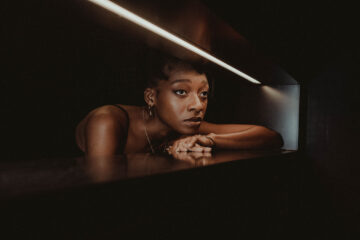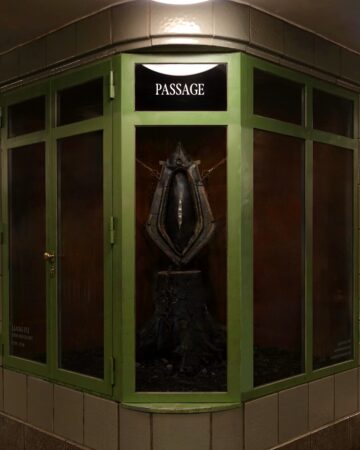
IN CONVERSATION WITH LITTLE SIMZ
On being brave: Numéro Berlin spoke with Little Simz about her freshly released sixth…




Trend scout and Creative Director Julian Daynov is one of the most influential voices in the German fashion industry, playing an essential role in elevating German fashion onto the global stage. Through his exhibition format ‘NEUDEUTSCH’, he showcases both designer labels and furniture brands at fashion weeks beyond Germany’s borders. After a successful debut at Pitti Uomo in Florence, he recently provided a platform for a diverse range of design talents at CIFF during Copenhagen Fashion Week. In this interview, he discusses his work as a curator, his vision as a creative director, and his mission as a trend scout.
Numéro Berlin: Today, you are an internationally renowned fashion expert. Back in the days, what inspired you to pursue a career in fashion, and was it always clear to you that you wanted to work in this field?
Julian Daynov: I believe the interest and affection towards aesthetics have always been part of me even in my childhood. Growing up surrounded by a diverse tapestry of cultural influence and heritage, innovation and tradition, Eastern and Western European and wildly American visual codes probably unlocked an immersive and eclectic personal taste. Probably like pretty much every kid obsessed with fashion, I had my first touch points with it through junior editorial and styling jobs in magazines, followed by first jobs in retail, buying, fashion direction and now an own consulting bureau specializing on brand building and communication strategy for lifestyle brands – I guess it has never been only clothing I was fascinated by – i felt an affinity towards pop culture and modern-day lifestyle as a whole and the “halo” around it: the way it is staged, the way it is promoted, the way it is sold and made desirable, the hype-building habits.
I definitely would not trade my path as it gave me a very broad spectrum and overview throughout the entire scope of the industry – sourcing, editorial work, styling, buying, merchandising, designing, promoting: all incremental part for what I do now.
What were your initial motivations for creating ‘NEUDEUTSCH‘?
An indivisible part of my job as Portfolio Consultant and Buyer throughout the years has always been dedicated to finding and showcasing new brands and designs, new aesthetics and creations.
“There is so much going on and I guess it never got the attention it deserves – we have to all train ourselves to break up with the cliché on German design being strictly functional and rather unagitated and channel more our personal “discovery” mode.”
What does ‘NEUDEUTSCH’ represent, and what criteria do you use to curate the artists, designers, and brands involved?
As this is my own take on the spheres of modern design and current lifestyle objects, I am obviously led by my personal aesthetic appreciation, but coming from a solid retail business background, I always believed (and still do, by the way), that commercial success is a key driver and growth factor for any designer, artist or brand. I am very much inspired by the dreamy and poetic essence or artistic extravaganza of so many fashion designers, but also know that without carrying out a certain “wearability” and “wider public desirability” and “justified affordability” aspect their triumph, growth and eventually even overall existence are strongly in danger.
This is why I tend to throw a “filter” within my curation process for NEUDEUTSCH and encourage the creativity and greatness of modern German design I believe could make it within a commercial context and retail scenery of concept shops, department stores, etc. I personally select every single designer / brand after keeping track of their work and creations for over some seasons and analyzing their development not only throughout their design signature, but also in their business growth mode.
What common themes unite the projects showcased by NEUDEUTSCH, and what differentiates them from each other?
How did the collaboration between NEUDEUTSCH and CIFF come about, and what differences do you see between your initial curation for Pitti Uomo and your current one for CIFF?
A lot it gravitating around the idea of creating visionary work – be it in apparel, in interior, object design or beauty – and the idea of the makers to kick off an entire movement with their work. I love including brands and designers with an attitude, with a strong visual signature and particular distinctive style. What differentiates the curation series in Florence and Copenhagen is the profile of the curation – i slightly adjusted the selection and adapt it to the business and visitor profile of the trade show. For example, the brands I exhibited at Pitti Uomo were very menswear-driven as this is the nature of the platform: buyers, press, visitors going to Florence were more keen on discovering a Menswear driven selection; for Copenhagen and the CIFF i opened up the profile a bit wider and made sure to include more interior / object design brands / beauty players as the trade show develops onwards and showcases more of these categories and attracts additional buying population of visitors from these areas. If the next show will be held a pure interior design forum, my curation will respectively be replicating this aspect.
How has working on this project influenced your personal view of fashion and culture?
I’ve always been more fascinated by “underdog” culture and “enabling” spirit in any dimension – i love discovering brands, objects, persons not many others know of and find it joyful to channel their creations be it though my looks, within my network or in my job. I think through NEUDEUTSCH it now is heavily reflected in my personal closet, in my homes, in my beauty routine. I am experimenting more, I am trying out more and this is the greatest part of it – i can only invite everyone to do so: it makes us all stand out and supportive towards ideas and visions of independent creatives and not necessairly huge corporates.
Is it important to separate personal taste from general potential when making selections?
There is two dimensions in this: the purely business one and the predominantly aesthetic one.
About the business one, I had to learn the hard way in my years as Buyer and Fashion Director. Keeping a “commercial” line present in a portfolio of a store is essential to the business. Of course you have to keep things “aspirational” and “innovative”, but let’s be frank – the business volumes ensuring success are rather the “moderate” ones; in the end, those are the brand-clients, who “pay” for the presence of the “cool kids”. So, sometimes I would find myself in a showroom of a brand I would never even think of wearing or whose products don’t particularly mirror my taste, but hey, those are in the end some of the best-sellers for the mass-consumer market, which keeps the boat floating and the business liquid.
Within NEUDEUTSCH this rule applies probably less noticeable, but definitely is a criteria i follow – i want the brands i curate and exhibit to start off in a business context and generate not only exposure, but revenue and growth. Still, though, they are all very unconventional and visionary, new and bold, exciting and daring but all in-line with a factor for commercial success which can be scaled up.
How was the feedback from your appearance at Pitti Uomo?
Frankly, I could not have dreamed of a better and more vibrant premiere of the project than at Pitti Uomo in Florence this January – I have been working with the leadership and brand curation team of Pitti for years in my retail times and they were always eager to do a special project together, so this is how NEUDEUTSCH actually kicked off as a traveling curation format, showcasing works by aspiring creatives from various areas of design, arts and crafts. The initiative has been entirely funded by Fondazione Pitti and is in fact a pure good-will-venture, which gives a platform and business networking opportunity for young brands complementary and tries to catapult them into the prime league of retail business and fashion industry context.
It was right at the Pitti Uomo where the journey for NEUDEUTSCH actually took off – I got involved into conversations with the CIFF and other major platforms, who were showed interest for the showcase and expressed their wish to host an issue. Excited to see where it’s going to be taking us next – me and mostly German design aesthetes whose work I keep on discovering and find fascinating.
Generating visibility, awareness and exposure at the right platforms and within a well-tailored network is essential to any business, to any cause, to any message. None of this would have been possible to do without the initial support of the Pitti Uomo and the CIFF picking up the idea and building it up on a larger scale. I think our local German consume culture and moreover the common attitude towards something “German”, towards something “new” are not very nurturing and instantly supportive; there is still a “note” and “flavor” or distrust when it comes to even local promotion or exposure – I don’t like that at all and wanted to “fight” it with the idea of NEUDEUTSCH. We can’t change that “German gene” overnight, but we can all make sure to give enough positive examples of new German design greatness, which deserves a chance and which convinces and satisfies not only via “function” but also via “design”.
In a way it is unfortunate than none of the German authorities have seen the potential of showcasing German design internationally through NEUDEUTSCH, but luckily innovative, daring, believing and welcoming organizations like Pitti Uomo and CIFF saw this opportunity and sensed this development in modern German visual and design culture and wanted to be the first to exhibit and celebrate it. The secret often is to be fast and take a chance – another lesson we need to learn as old-Germans.
Are there other fashion weeks or locations you would like to bring NEUDEUTSCH to?
I am thrilled to see that the attention and interest for NEUDEUTSCH is growing and am extremely proud that major international platforms from the US, from Paris, Milan, Hong Kong, Tokyo and Seoul have already expressed their enormously generous invitations to host the showcase and give stage and market entry opportunity for the designers I believe would be worth showcasing and introducing onto their media and business scene. I guess we’ll be traveling abroad very soon again but wish it would also take the courage of our local German authorities to support and enforce an initiative showcasing German talent and design culture internationally, as so far, it’s rather been more the ones as Pitti Uomo and CIFF who entirely fund our German creative exposure and advocate internationally for the actual attention towards German design.

On being brave: Numéro Berlin spoke with Little Simz about her freshly released sixth…

With his latest installation "SPINE BOUNDARY" at Hermannplatz, Berlin, Chinese born Artist…

Once a challenger brand in the automotive world, CUPRA has steadily entered a new era, one…
Interview by Chiara Anzivino